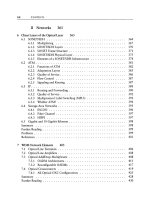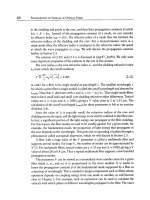Optical Networks: A Practical Perspective - Part 1 ppsx
Bạn đang xem bản rút gọn của tài liệu. Xem và tải ngay bản đầy đủ của tài liệu tại đây (471.35 KB, 10 trang )
The readable style, balanced coverage of transmission and networking issues, and inclusion of real-world
issues has been carried forward from the first edition into this second edition. This new version provides
timely updates on emerging technologies that will shape the deployment of optical networks for years to
come.
mThomas S. Afferton, District Manager, Advanced Transport Technology and Architecture Planning,
AT&T Network Services
The second edition of
Optical Networks
impressively covers the new technologies that have taken flight
since the release of the first edition. The result is a fine text that provides comprehensive and detailed
information on optical technologies and networks for students, professionals, and researchers.
Joseph Bannister, Director, Computer Networks Division, Information Sciences Institute, USC
In the second edition, Ramaswami and Sivarajan have continued to provide a concise approach to
this broad and multidisciplinary field and to strike an important balance between device and transport
physics and transmission engineering, network protocols, and architectures. Readers will value the
important updates on technology advances and their impact on future network architectures.
Daniel J. Blumenthal, Professor of ECE, University of California, Santa Barbara and Cofounder,
Calient Networks
The horizons of optical networks are much more than high speed physical layer transport. An intelligent
optical network design must include higher network layer considerations. This is the only book currently
on the market that addresses optical networks from the physical layer to the network layer and should be
valuable for those who try to understand the intricacies of what optical networks can be.
Vincent Chan, Professor, MIT Department of Electrical Engineering and Computer Science
This book is not only essential reading for anyone in the optical networks industry, it is important. It
provides the necessary foundation of learning for anyone hoping to contribute to this technology's rapid
evolution.
mScott Clavenna, President, PointEast Research
The authors" grasp of what is truly workable and worthwhile in optical networks is fundamental, and
they have effectively packaged this knowledge in an easy-to-comprehend text that will be valued to both
veterans and those new to optical networking.
Scott Grout, President and CEO, Chorum Technologies
This is a comprehensive and authoritative work on optical networks, ranging in scope from components
and systems to overall design principles. I find the book well organized and easy to use, and I particularly
like the treatment of network design and operation. An essential book for anyone seriously interested in
optical networks.
Goff Hill, Chief Network Architect, Altamar Networks, UK
The second edition of this widely read text will be a valuable resource for students and engineers alike. It
provides extensive coverage not only of topics related to current practice, but also techniques being
researched, which may be deployed in the future.
mDr. David Hunter, Senior Researcher, Marconi Labs, Cambridge, UK
The authors have done an excellent job of updating the content with all the new developments in optical
networking in this second edition. Optical networking is a rapidly changing technology that can support
the enormous Internet traffic growth demands required by bandwidth intensive applications of the
21st century.
Rao Lingampalli, Senior Technical Marketing Manager, Calient Networks
I really enjoy the bottoms-up approach taken by the authors to address fundamentals of optical
components as the enablers, optical transmission system design and engineering as the building blocks,
and network architecture and its management features that deliver applications to the network operators
and services providers at the top of the food chain.
~Shoa-Kai Liu, Director of Advanced Technology, Worldcom
This book not only provides the fundamentals and details of photonics, but the pragmatic perspective
presented enables the service provider, the equipment manufacturer, and the academician to view light
from a real-life standpoint.
Mathew Oommen, Vice President, Network Architecture, Williams Communications Group
This book functions as both an introduction to optical networking and as a text to reference again and
again. Great for system designers as well as those marketing and selling those systems. Optical Networks
provides theory and applications. While no text can be truly state-of-the-art in the fast moving area of
optical networking, this one comes as close as possible.
mAlan Repech, System Architect, Cisco Systems Optical Transport
This book provides the most comprehensive coverage of both the theory and practice of optical
networking. Its up-to-date coverage makes it an invaluable reference for both practitioners and
researchers.
mSuresh Subramaniam, Assistant Professor, Department of Electrical and Computer Engineering,
George Washington University
This book definitely provides the most comprehensive coverage of the technologies, architectures, and
applications essential for the study of the optical networking field. This second edition is very well
written and organized, and the new topics covered appropriately reflect many of the latest technology
and standards developments within our industry.
Mark R. Wilson, Ph.D., Adjunct Professor of Electrical Engineering, University of Pennsylvania;
Senior Manager, Optical Network Architectures, Agere Systems
This book provides an excellent overview of the complex field of optical networking. I especially like
how it ties the optical hardware functionality into the overall networking picture. Everybody who wants
to be a player in the optical networking space should have this book within easy reach.
Martin Zirngibl, Director, Photonics Network Research, Lucent Technologies, Bell Laboratories
Optical Networks
A Practical
Perspective
Second Edition
The Morgan Kaufmann Series in Networking
Series Editor, David Clark, MIT
Optical Networks: A Practical Perspective, 2e
Rajiv Ramaswami and Kumar N. Sivarajan
Telecommunications Law in the Internet Age
Sharon K. Black
Internet QoS: Architectures and Mechanisms
Zheng Wang
TCP/IP Sockets in Java: Practical Guide for Programmers
Michael J. Donahoo and Kenneth L. Calvert
TCP/IP Sockets in C: Practical Guide for Programmers
Kenneth L. Calvert and Michael J. Donahoo
Multicast Communication: Protocols, Programming, and Applications
Ralph Wittmann and Martina Zitterbart
MPLS: Technology and Applications
Bruce Davie and Yakov Rekhter
High-Performance Communication Networks, 2e
Jean Walrand and Pravin Varaiya
Computer Networks: A Systems Approach, 2e
Larry L. Peterson and Bruce S. Davie
Internetworking Multimedia
Jon Crowcroft, Mark Handley, and Ian Wakeman
Understanding Networked Applications: A First Course
David G. Messerschmitt
Integrated Management of Networked Systems: Concepts, Architectures, and their Operational Application
Heinz-Gerd Hegering, Sebastian Abeck, and Bernhard Neumair
Virtual Private Networks: Making the Right Connection
Dennis Fowler
Networked Applications: A Guide to the New Computing Infrastructure
David G. Messerschmitt
Modern Cable Television Technology: Video, Voice, and Data Communications
Walter Ciciora, James Farmer, and David Large
Switching in IP Networks: IP Switching, Tag Switching, and Related Technologies
Bruce S. Davie, Paul Doolan, and Yakov Rekhter
Wide Area Network Design: Concepts and Tools for Optimization
Robert S. Cahn
Practical Computer Network Analysis and Design
]ames D. McCabe
Frame Relay Applications: Business and Technology Case Studies
]ames P. Cavanagh
For further information on these books and for a list of forthcoming titles,
please visit our Web site at
www.mkp.com.
Optica I N etworks
A Practical
Perspective
Second Edition
Rajiv Ramaswami
Kumar N. Sivarajan
M ~4 ~
MORGAN KAUFMANN PUBLISHERS
A n Im print of Elsevier
SAN FRANCISCO SAN DIEGO NEW YORK BOSTON
LONDON SYDNEY TOKYO
Editor Rick Adams
Publishing Services Manager Scott Norton
Senior Production Editor Cheri Palmer
Assistant Acquisitions Editor Karyn Johnson
Cover Design Ross Carron Design
Cover Image Q Dominique Sarraute / Image Bank
Text Design Windfall Software
Copyeditor Ken DellaPenta
Proofreader Jennifer McClain
Indexer Steve Rath
Printer Courier Corporation
This book has been author-typeset using LATEX.
Designations used by companies to distinguish their products are often claimed as trademarks or
registered trademarks. In all instances in which Morgan Kaufmann Publishers is aware of a claim, the
product names appear in initial capital or all capital letters. Readers, however, should contact the
appropriate companies for more complete information regarding trademarks and registration.
Morgan Kaufmann Publishers
An Imprint of Elsevier
340 Pine Street, Sixth Floor, San Francisco, CA 94104-3205, USA
h ttp ://www. m k p. com
ACADEMIC PRESS
An Imprint of Elsevier
525 B Street, Suite 1900, San Diego, CA 92101-4495, USA
h ttp'//www.academ icpress, corn
Academic Press
Harcourt Place, 32 Jamestown Road, London, NW1 7BY, United Kingdom
h ttp ://www.academicpress. corn
9 2002 by Academic Press
All rights reserved
Printed in the United States of America
06 05 5 4 3 2
No part of this publication may be reproduced, stored in a retrieval system, or transmitted in any form
or by any means electronic, mechanical, photocopying, or otherwise without the prior written
permission of the publisher.
Permissions may be sought directly from Elsevier's Science and Technology Rights Department in
Oxford, UK. Phone: (44) 1865 843830, Fax: (44) 1865 853333, e-mail:
You may also complete your request on-line via the Elsevier homepage: by
selecting "Customer Support" and then "Obtaining Permissions".
Library of Congress Control Number: 2001094371
ISBN 1-55860-655-6
This book is printed on acid-free paper.
To our parents.
This Page Intentionally Left Blank
Foreword
by Paul E. Green, Jr.
Director, Optical Network Technology (retired)
Tellabs, Inc.
If anyone needed evidence of the rapid pace of innovation in WDM optical telecom-
munications, a year-by-year perusal of the innovations reported in the journals and
in the activities of start-up companies in the optical space would provide all needed
persuasion. While the field is old some fifteen years to be exact~it is also young
in the sense that almost nothing in the technology has reached steady-state maturity.
New optical bands are being opened up, unprecedented bitrates are being carried
per wavelength over all-optical distances that were not thought possible not long
ago, new forms of fiber are being introduced, and point-point links are now being
organized by their owners into rings and other real network structures, using new
optical switching and routing technologies.
Thus, it is a most welcome development to see that Ramaswami and Sivarajan
have reorganized and updated their outstanding
1998
traversal of this fascinating
and important field and have done so in a way that accurately portrays what is going
on. The first edition reflected the authors' backgrounds, straddling the academic
and industrial research community on one hand and the school of commercial hard
knocks on the other, and it is still true that this new book provides a view of optical
communication that is lacking in other frequently updated volumes in this field,
whose authors lack the authority possessed by Ramaswami and Sivarajan.
At this juncture, there is a pause in the headlong rush to provide ever more band-
width to everybody, and the reasons are not just economic. The bottleneck between
the gigabit environment on everyone's desktop and the terabit environment of the
telco and cable fiber infrastructure is a consequence of the failure of the available
"last mile" communication technologies to seriously meet the challenge of providing
ix









